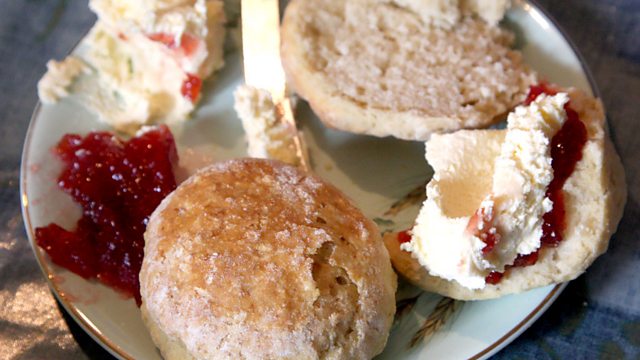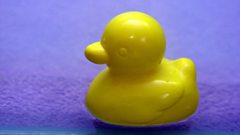
10/01/2013
As we continue with this week's story The Silver Bead, we find out how to control pesky seagulls and discuss which goes on your scone first - jam or cream?
Last on
Clip
-
![]()
Dick and Dom: Bathroom
Duration: 12:43
Activity 1: Measure your volume
Have you noticed that when you get into the bath, the level of the water goes up? The water is displaced by your body when you climb in. The amount it is displaced is equal to your volume. When you get out of the bath, the water level goes down again. So you can use your bath, and a large measuring jug, to work out your own volume. You'll also need something to mark the water level – a piece of coloured sticky tape works well.
��
Fill the bath enough to cover you completely when you get in. In you get!
Lie in the bath so as much of you is under the water as possible. Use the tape to mark the level the water has risen to.
��
Then, get out of the bath. When you're dry, take the measuring jug and fill it from the sink. Pour it into the bath. Keep filling the bath until the water reaches the level you'd marked with the tape. Keep count of how many litres of water it takes to reach the tape. The amount of water you have refilled the bath with will be approximately equal to the volume of... you!
��
You can also use this information to work out your density. If you weigh yourself in kilograms, then divide this number by your volume in litres, you will find your density in kg per litre. Water has a density of 1kg per litre. Is your density greater or less than this?
Activity 2: Make bath bombs
Bath bombs are toiletries which when dropped into a bath dissolve and fizz. If you can get hold of the ingredients you can make your own. You should be able to buy them from a chemist, or on the internet.
��
You will need:
- ��200g sodium bicarbonate
- 100g citric acid powder
- a few drops of witch hazel, ideally from a spray bottle
- colouring (if you can't find powdered colouring for cosmetics, you can use a tiny amount of food colouring)
- small moulds for the bath bombs (you can make your own by cutting off the end of a small drinks bottle)
- ��greaseproof paper
��
This will make 3-4 bath bombs.
��
Put the dry ingredients in a bowl, and mix well with a hand whisk. Add the food colouring. If you’re using liquid colouring you only need a tiny amount. To bind the mixture together, add a few drops of witch hazel, and mix well. Be careful not to add too much liquid – it will set the reaction off too soon! The mixture is ready when you can press it into the sides of the bowl and it just sticks together.��
��
Quickly press the mixture into the moulds, pushing down well so you get as much into the mould as possible. Then, turn your bath bomb out of the mould onto the greaseproof paper, and leave to dry overnight in a warm place.
��
When you drop your bath bomb into the water, it fizzes and bubbles appear. When you add the citric acid and sodium bicarbonate to water, they react together, to create more water, a harmless salt called sodium citrate, and carbon dioxide gas. It's the carbon dioxide which makes it fizz. Your bath bombs work best in a hot bath: a lot of chemical reactions work more quickly at warm temperatures.
Activity 3: The Egg and the Toothbrush
Ever wondered why you should use toothpaste to brush your teeth?
You will need:
- a hard-boiled egg with the shell on
- a toothbrush (not your own, or anyone else's! It's best to use a toothbrush that no-one is going to actually use on their teeth for this experiment)
- ��toothpaste
- ��a mug full of cola
Boil your egg (or ask an adult to boil you an egg) and let it cool. It's best to use an egg with as pale coloured a shell as possible. Once your egg has cooled down, place it in the mug full of cola. Leave it to soak for 5-6 hours or if you can, overnight. Then remove your egg from the fizzy drink. What has happened to its shell? Can you get it clean again using the toothpaste and toothbrush?
What's happening?
The colouring from the fizzy cola has stained the shell of the egg. You can see how effective toothpaste is for cleaning by brushing the egg clean. When you clean your own teeth, you are brushing away not just the colouring from any food you have eaten, but also a layer of food, saliva and bacteria called plaque. If you don't brush your teeth, the acid the bacteria produces as it breaks down the sugar in your mouth can eat into the enamel of your teeth, creating holes, or cavities, which is what has happened when you need a filling.
Broadcasts
- Thu 10 Jan 2013 16:0091�ȱ� Radio 4 Extra
- Thu 21 Mar 2013 16:0091�ȱ� Radio 4 Extra

